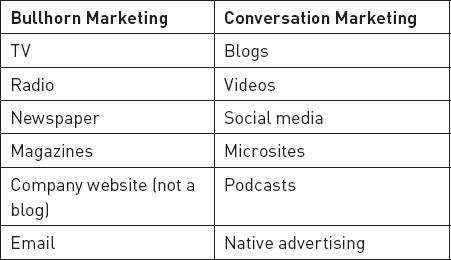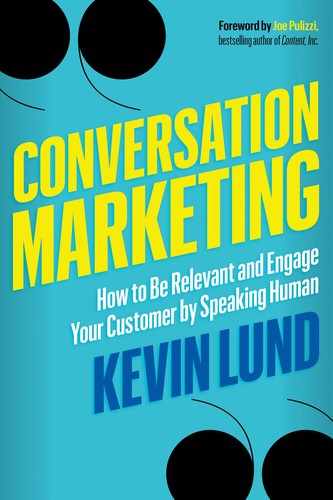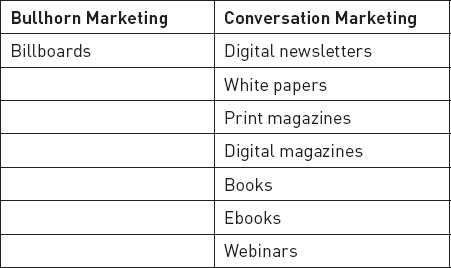CHAPTER 4
Pick Your Party
So far, the discussion has centered on how to join in and have a meaningful conversation with your audience. Here, the discussion moves from the rules of engagement in your conversation to the venue (i.e., choosing your channels). Equally important to the how of your conversation is the where. It should all fit seamlessly together when you think about it; part of learning how to talk to your audience and engage them in conversation is deciding where to talk to them in the first place. In essence, you have to pick your party.
Your content marketing strategy consists of multiple touch points along the path to purchase, all part of a content ecosystem. The conversation you are having as part of your content marketing strategy doesn't begin and end with your individual channels. Even though it's possible to get a sale or track business from a single channel, that isn't the primary goal of the channel, nor should it be. Each of your channels serves a unique purpose, with one channel leading into another. That said, whether you utilize one channel or multiple channels working together, content marketing takes time. As you know well, no path to purchase is a straight line.
Forget About the Sale (for the Moment)
You're earning a relationship with your audience, not buying one. In content marketing, the path to purchase is not a straight line. As mentioned at the beginning of the chapter, your content marketing strategy does not begin and end with a single channel. Remember that your content is created to attract and retain your customers. It's not your point of sale. Instead, your content channel is your sales incubator.
That's not to say you won't win a few sales in one take with a single piece of content. I'm simply arguing that a few sales successes from a single piece of content would be the exception, not the rule. A billboard on a highway only drives sales if someone is hungry and sees a McDonald's ad for fifty-cent Big Macs. That's great for quick pops. But a well-thought-out channel strategy in content marketing is intended to nurture a relationship, bring a captive audience closer to your brand, and evoke meaningful action or engagement from that audience.
First, you must set a realistic goal for your content.
Weak: “Let's start a blog to generate sales.”
Better: “Let's engage our clients with a blog, build an audience, earn their trust, and provide them value in the short term, as well as the long term.”
By way of example, absent the sale, some key performance indicators (KPIs) of a blog that would determine success right out of the gate are:
- Traffic: How many people come to the site, from where (other sites, inbound links, influencers), and how (devices like mobile, tablet, etc.)?
- Engagement: Did they leave right away (bounce rate)? How long did they stay? How many pages did they read? Where did they go from there?
- Effectiveness: What did they do when they got there? Did they respond to your call to action? Did they share it?
Pitching products is widely accepted in more traditional “bullhorn” marketing channels such as TV, radio, newspapers, and magazines. And it's appropriate on your own website—just not your blog. Though any channel can be used for both bullhorn and conversation marketing, the following is a cheat sheet to remind you which channels are better suited for tooting your own horn versus having a conversation.

How to Create Your Channel Plan
When you begin to create your channel distribution plan, you start by asking: “What am I trying to accomplish?” Dig deeper than simply “We want to generate sales from our content.” Instead, focus your attention on a solid engagement goal like “We want to be the top-ranked site to address pain points for welding suppliers.”
Next, ask yourself: “How do we want to get there?” All the while keep in mind it's not a straight line. What is your content marketing strategy designed to accomplish?
Then, determine where your customers are hanging out. Use all the research tools at your disposal, including surveys, direct calls (calling your customers personally to ask), keywords, social media listening, trolling social media, and industry blogs.
The final step in your channel strategy is the development of the channels themselves. In the beginning, cast a wide net, but choose your channels wisely. Not everyone needs a Facebook, Twitter, and LinkedIn channel, for example. The need for all of them is overblown, so you'll want to answer two important questions:
- Why do you need this channel? and
- How does this channel fit into our goal?
For example, if you're a B2B business, LinkedIn, a place where other professionals in your industry are seeking out information and expertise, might be a good channel to focus your resources. On the other hand, if you're a B2C business, Facebook or Instagram might be a place to focus your resources to reach your audience.
In Detail: A Content Marketing Channel Plan
As you develop your channel distribution plan, there are multiple factors to consider. You should start with an examination of your current position to decide where your story will have the most impact on your audience. Note the content marketing strategies you already have in place (website, blog, Facebook, etc.) relative to where (Instagram, LinkedIn, a new blog, etc.) you'd like to see your latest efforts succeed. Once you have a handle on your current situation, consider what you need to change, stop, or add to more effectively tell your story. From these factors, you can set new priorities and goals.
Next, consider each channel's objectives in relation to one another. Where do your objectives need an overhaul? What channels overlap with one another, and is there a way to make that overlap more effective? Now determine how to make your channel objectives effectively accomplish your goals.
Now, for each channel you've identified, you need to plan your content to tell your story in a way that reaches the audience specific to that channel. The content may be different to reach the audience at each channel, but your story should be consistent throughout all channels. With each channel, you will need to identify audience members in order to reach them effectively, keeping in mind that on social media you may want more than one account to reach each unique following. Whether you are building community on Facebook or delivering sought-out information on LinkedIn, your content and your context should focus on each unique audience while maintaining the integrity of your story within the conversation.
For each channel, as well as the overlapping channels, you need to identify and understand the goals for each channel (e.g., 100 new Facebook followers in a month, fifty shares of an informative article on LinkedIn, etc.). Once you identify the goals, ensure that you have the people as well as the tools to manage the content and conversation on each channel.
Finally, your channel distribution plan needs a schedule or a calendar to define the factors needs to achieve your goals. Each channel's schedule should include a posting schedule for content, a unique tone and structure, as well as the action you hope to gain from the audience.
As an example, here's a hypothetical content marketing channel strategy you might take if you're a B2B firm:
- Create a social media presence on LinkedIn.
- Start blogging on the influencer pages to build an audience.
- Begin sending your audience to deep links on your company's own blog (your primary content source).
- Add calls to action (CTAs), embedded links, and lead generation devices (e.g., newsletter sign-ups) in your blog posts asking your readers to do something. (Prospects could remain here for some time.)
- Ask for the sale on your site.
The process from Step 1 to Step 5 could all take one day or many months. It all depends on how you execute your strategy, how well you're telling your story overall, and how well-crafted your content is.
Remember that every company is different, and your channel distribution plan won't look exactly like anyone else's. To achieve your goals, you will likely need to experiment, seek feedback, and continue to make changes along the way.
A Tentacled “Conversation Ecosystem”
Your channel strategy should be a tentacled “conversation ecosystem” of multiple conversations. As previously mentioned, you have to cast a wide net of channels that play off one another. One channel starts a conversation and then leads to another channel, though they remain interconnected. Media companies and toy manufacturers have this down to a science, including LEGO and the action/superhero franchises like Marvel/DC.
Embrace Channels for What They Are Today
As you pick your party and develop your channel distribution strategy, you have to embrace the channels for what they've become today, not what they once were. Think about it: Instagram isn't just for photos anymore, and the YouTube of today is not the video-sharing website it was when it started. It has become a massive, unregulated global television network.
Samsung Malaysia embraced YouTube with a miniseries of videos of their own. The series follows a tribute band about to get their “big break” when their lead singer, who not only has to leave the country, falls ill two weeks prior to their showcase performance. Samsung understood that you have to think about YouTube as a media platform beyond cat videos and novelty. It can be an effective channel strategy for those who jump into a high-quality, storytelling visual content realm. Not one person discusses Samsung the brand, but the video clearly demonstrates how the brand's products (mostly their smartphones) could be used in smart ways to help you in your life (or in this case, save the band).
Putting It All Together: The Editorial Calendar
The time has come to pull all this information together, and to do it, you need to organize and create an editorial calendar for your channel distribution strategy. If you've never used one, an editorial calendar is a tool that helps you manage a single conversation or multiple ones across one or more channels, for at least the next month or two (likely more). The editorial calendar should also guide your team on strategy, topic, frequency, and schedule of the content you intend to create.
Whether you prefer an uncomplicated spreadsheet or a detailed interactive calendar for your content production and distribution, your editorial calendar will be unique to your brand. To begin your editorial calendar creation, start by gathering information from your content marketing plan. Your audience is priority one, so stay focused on their information needs while you determine your content goals (leads, attendance, etc.). As you plan what, where, and how often to publish, keep in mind your team and their expertise as well as your resources and what limitations you have. Will you be using in-house staff or outsourcing your content?
Armed with that information, you can begin setting up your editorial calendar. You may want to start simply with an Excel spreadsheet or a Google Sheet, but if you choose to go with a calendar app, you'll find many that offer not only calendar tools, but collaboration tools as well (e.g., Trello, CoSchedule, Google Calendar, etc.). Most important is that the editorial calendar can be easily designed, shared, and accessed by your team. Your editorial calendar will have unique fields, but everyone can benefit from some uniform fields like these: date of content publication, content title/topic, content author, business stakeholder, status of content. In addition, you may want to add fields to track details like content formats, keywords (SEO), visuals (images, logos, etc.), platforms (channels), URLs, velocity (time tables), calls to action, impact, and even goals.
Your editorial calendar is now ready to go, and it's up to you to keep it filled with content topics and ideas that keep the conversation going with your audience. A calendar filled with ideas will help you manage and streamline content, and manage your workflow and publication schedule across all your channels, all the while keeping you and your brand moving in the right direction.
Icebreaker
As you prepare your next campaign, answer these questions to engage your audience, start a conversation, and bring about positive actions as a result.
- Where are your customers “hanging out” online? You either know this or need to research this using data sources (such as the listening tools that we will cover in Chapter 6).
- What are the most effective content channels for your niche? Where can you best reach potential customers who may be unaware of your message and your brand? It may be YouTube, Facebook, Twitter, Instagram, a traditional blog, a newsletter, or even a microsite.

